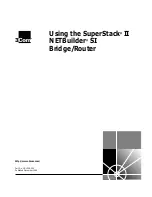
IDT NTB Upstream Port Failover
PES16NT2 User Manual
7 - 3
April 15, 2008
Notes
When a dynamic failover occurs, upstream and NTB port data queued in the switch, data being trans-
mitted, and data in the replay buffers may be lost. Thus, some interruption of PCIe traffic should be
expected with a failover. While it may be possible to design a system in which no PCIe traffic is lost or
corrupted during a failover, such an implementation is beyond the scope of this specification.
Registers used to manage failover are located in the address space of the external NTB endpoint. Thus,
they may be accessed by the primary or secondary roots. They may also be accessed by any PCIe device
in the internal or external PCIe hierarchies when NTB endpoint configuration space is memory mapped
using BAR4.
The current failover state (i.e., normal mode or failover mode) may be determined by reading the
Current Failover Mode (CFMODE) field in the Failover Status (FOVRSTS) register. Whenever, a dynamic
upstream port failover is initiated (i.e., starts), the Failover Mode Change Initiated (FMODECI) bit is set in
the FOVRSTS register. When a dynamic failover completes, the Failover Mode Change Completed
(FMODECC) bit is set in the FOVRSTS register. These bits are sticky and thus their status is preserved
across a hot-reset. The operation of the upstream port failover mechanism is unaffected by a hot-reset.
Once a failover is initiated, the failover sequence runs to completion and can only be aborted by a funda-
mental reset.
Static Upstream Port Failover
A static upstream port failover requires a fundamental reset to be initiated whenever a failover mode
change is required. Since the initial failover mode is selected by the switch mode in the boot configuration
vector, the static upstream port failover feature may be viewed as nothing more than the ability to select the
failover mode during a fundamental reset.
An static upstream port failover consists of the following steps:
– Assert the PCIe fundamental reset signal (PERSTN)
– Modify the switch mode (SWMODE) signals to the selected failover mode (i.e., normal mode or
failover mode).
– Negate the PCIe fundamental reset signal (PERSTN)
Since initiation of an upstream port failover requires a fundamental reset of the internal PCIe hierarchy
and external NTB endpoint, many systems may require the use of dynamic upstream port failover.
Dynamic Upstream Port Failover
Dynamic upstream port failover allows a failover to occur while the system is live and in a manner that
preserves the system state.
When a dynamic upstream port failover is initiated, PES16NT2 takes the following actions.
– The LTSSM associated with the upstream port (i.e., port A) and the NTB port (i.e., port C) imme-
diately transition to the Detect state and the data link layer transitions to the DL_Down state. This
causes data in the replay buffer associated with ports A and C to be discarded and may cause
data queued in the switch core for these ports to be discarded.
– The state of the SerDes switch is modified as selected by the failover mode (i.e., pass through or
swapped).
– The LTSSM initiates link training on the upstream port (i.e., port A) and the NTB port (i.e., port C).
The PxLINKUP and PxLINKDN bits in the INTSTS registers associated with both the internal and
external NTB endpoints are not set during a dynamic upstream port failover. The link down and later link up
associated with a dynamic upstream port failover are masked from causing these bits from being set. See
section Link Status on page 3-5 for a description of the PxLINKUP and PxLINKDN bits.
In most systems it is expected that only one failover mechanism will be enabled at a time. If a failover of
the same type (i.e., software, signal, or watchdog timer) is initiated while one is already in progress, the
second initiation will be lost. If a failover of a different type is initiated while one is in progress, the failover
will be performed once the one in progress completes. Software may utilize the Failover Mode Change
(FMODECC) and Failover Mode Change Initiated (FMODECI) bits in the FOVRSTS register to avoid
failover race conditions.
Содержание 89HPES16NT2
Страница 14: ...DT List of Figures PES16NT2 User Manual viii April 15 2008 Notes...
Страница 20: ...IDT Register List PES16NT2 User Manual xiv April 15 2008 Notes...
Страница 32: ...IDT PES16NT2 Device Overview PES16NT2 User Manual 1 12 April 15 2008 Notes...
Страница 44: ...IDT Clocking Reset and Initialization Clock Operation PES16NT2 User Manual 2 12 April 15 2008 Notes...
Страница 50: ...IDT Link Operation PES16NT2 User Manual 3 6 April 15 2008 Notes...
Страница 62: ...IDT Power Management PES16NT2 User Manual 5 4 April 15 2008 Notes...
Страница 78: ...IDT SMBus Interfaces PES16NT2 User Manual 6 16 April 15 2008 Notes...
Страница 83: ...IDT NTB Upstream Port Failover PES16NT2 User Manual 7 5 April 15 2008 Notes...
Страница 84: ...IDT NTB Upstream Port Failover PES16NT2 User Manual 7 6 April 15 2008 Notes...
Страница 130: ...IDT Transparent Mode Operation PES16NT2 User Manual 9 44 April 15 2008 Notes...
Страница 284: ...IDT Non Transparent Mode Operation PES16NT2 User Manual 10 154 April 15 2008 Notes...
















































